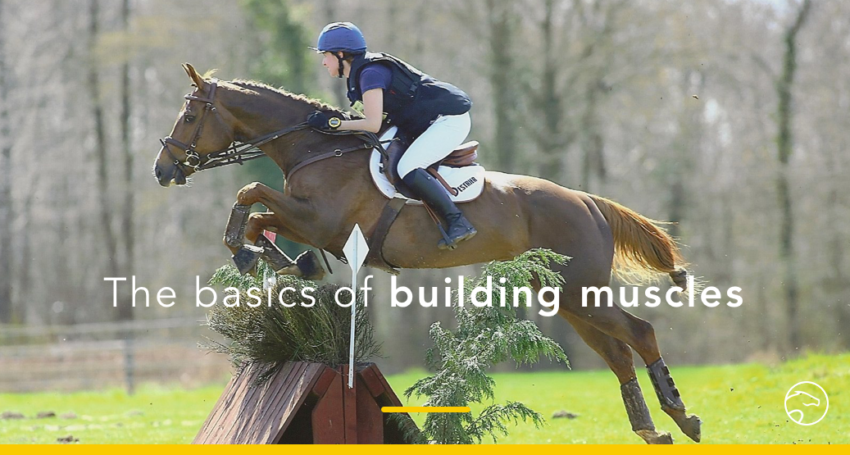
7 “Must Know” About Your Horse’s Muscles
All riders are a little obsessed with having a pretty and well muscled horse. However, as we do not have dumbbells nor gyms for horses yet, we must train “gymnastics” with them! But how effective is this? Have you ever wondered why you are training that? How does a horse get muscled? We will give you all the ins and outs in this article!
Updated the 29 th of May 2018
I interviewed Dr. Emmanuelle Van Erck, veterinarian of some of the greatest riders in the world, and a member of the Equisense Scientific Committee. The muscles of the horses will have no more secrets for you.

Your horse after you are done reading this article 😂
Table des matières
#1 – Different types of muscles
Let’s start with a bit of anatomy and physiology in order to understand what all of this is about.
There are 3 types of muscles:
- Skeletal muscles. They are the ones connecting the different bone segments to each other.
- Smooth muscles. These muscles are not voluntarily controlled. Such as: digestive tract muscles, the esophagus and the blood vessels’ wall.
- Cardiac muscles. This is an intermediary between the two previous types of muscles.
In this article, we will only talk about skeletal muscles due to being the only ones we are able to voluntarily control. I could try to advise you on how to strengthen your intestines but that probably won’t work…😁
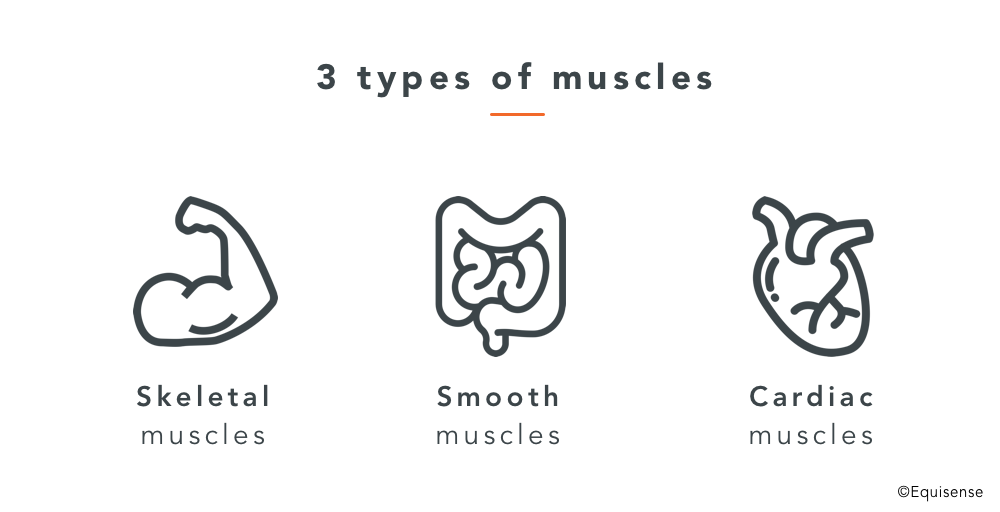
To make it simple, a skeletal muscle is a grouping of muscle fibers. There are several types but three main ones. Depending on the fiber composition of the muscle, it will have different reactions to effort.
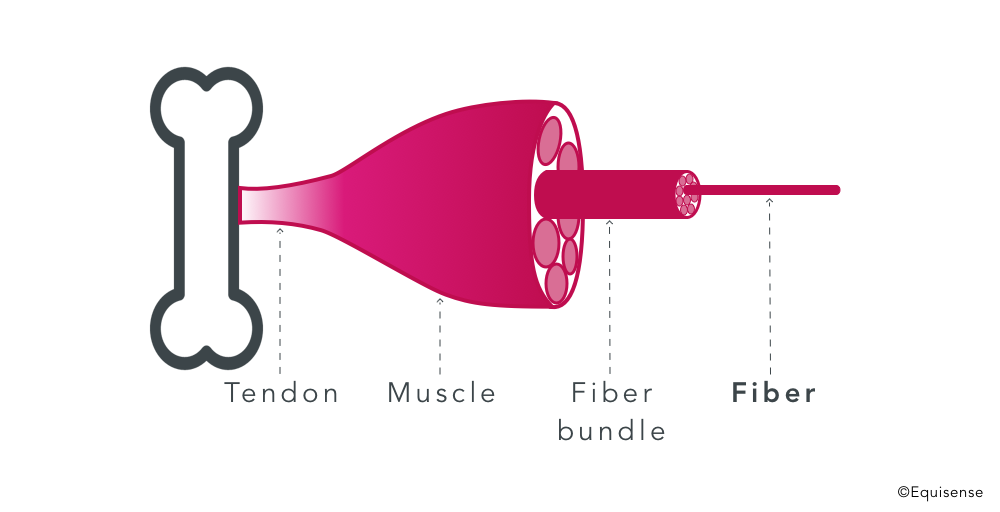
- Red fibers or slow fibers (type I) are fibers that contract slowly, with a relatively low force but are very resistant to fatigue. They need oxygen in large quantities explaining why they are highly vascularized. They are thus adapted to the long-lasting exercises, endurance type.
- White fibers or fast fibers (type IIB). Type IIB fibers contract quickly and forcefully but get tired very quickly. They are therefore adapted to short-term exercises. These are fibers adapted to exercises like sprints.
- Type IIA fibers have a moderately fast, moderately strong contraction and are moderately fatigable. They are intermediate between Type IIB and Type I fibers.
Let’s summarize:
| Type I | Type IIA | Type IIB | |
| Aspect | Red | Pink | White |
| Diameter | Small | Medium | Big |
| Strength | Weak | Medium | Strong |
| Fatigability | Low | Medium | High |
| Contraction | Slow | Medium | Fast |
| Effort type | Endurance | Intermidiate | Sprints |
#3 – Fibres distribution
The distribution of fibers depends on several aspects
Distribution depending on muscles
« Postural » muscles are needed all the time in order to keep the horse in a standing position. As such, they must be rich in Type I and Type IIA fibers. These muscles are for exemple: back muscles and jaw muscles. Some of the jaw muscles are made of 100% of Type I fibers.
Conversely, some muscles of the thighs such as the semi-tendinous contain only 5% of type I fibers. These muscles are therefore only dedicated to fast and energetic movements.
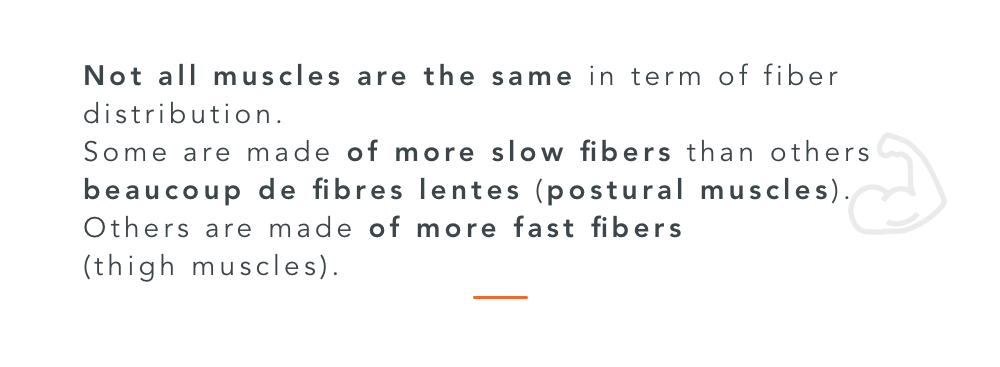
Distribution depending on horse breed
Indeed, depending on the different horse breeds, for a given muscle, the distribution between the different types of fibers can vary enormously. This explaining why some breeds are more predisposed to stamina efforts than others!
Let’s use the example of the middle gluteal muscle (a muscle in the buttock). For the Quarter Horse it contains on average 9% of type I fibers, against … 24% for the donkey! The Quarter Horse is as well the one breed with the most Type IIB fiber for this muscle (40%), which is why he is an excellent sprinter.
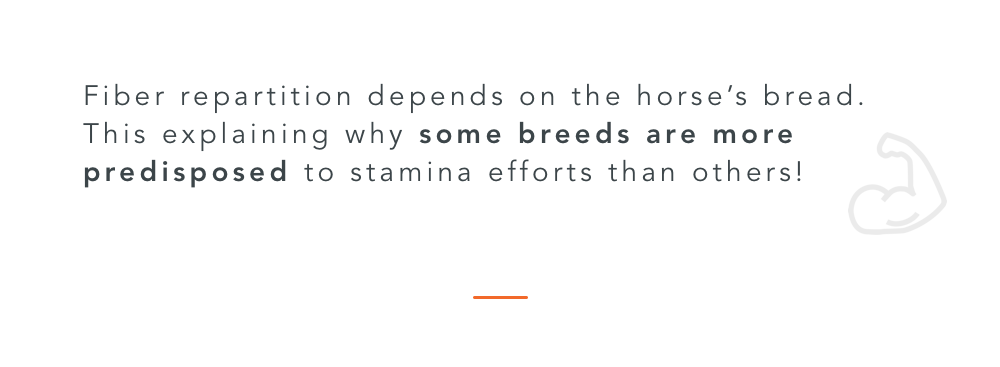
So please, do not try to race your donkey, you will for sure lose…
Distribution depending training
Finally, training can also influence the distribution of fibers.
Indeed, the more you work the “long and slow” type of endurance exercises (long flat sessions, trotting hacks …), the more you increase the percentage of type I fibers.
Conversely, the more you work explosive exercises (cavalettis, bounce jumps, stop start, short fast races…) the more you increase the percentages of type II fibers.
Depending on what you do as a discipline, it is important to have a well balanced and adapted work!
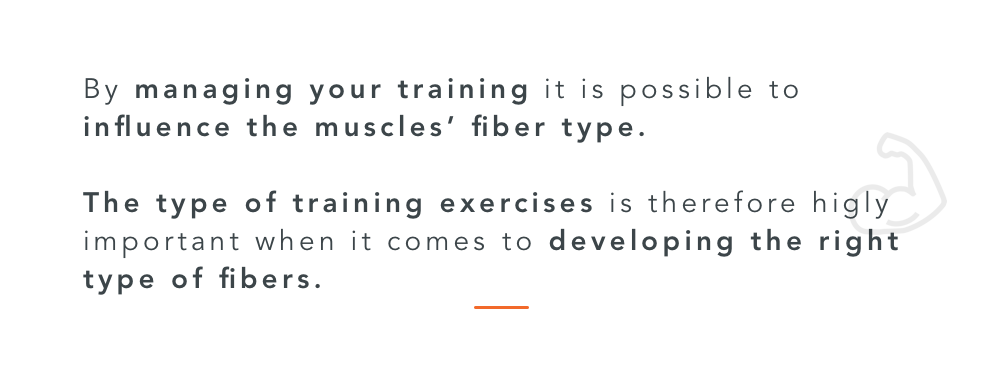
It is exactly the same for human beings! Marathon runners gain in type I while training their stamina. Moreover, types I are a diameter smaller than type II therefore, explaining why marathoners are “dry” !
Conversely, body builders will train to lift heavy loads on short efforts. They will therefore increase the percentage of type II fibers that are larger in diameter! 💪
Do not ask a bodybuilder to run a marathon. Unless you want to laugh… 😂
📚 To read : Myositis, or “Monday Morning Disease”
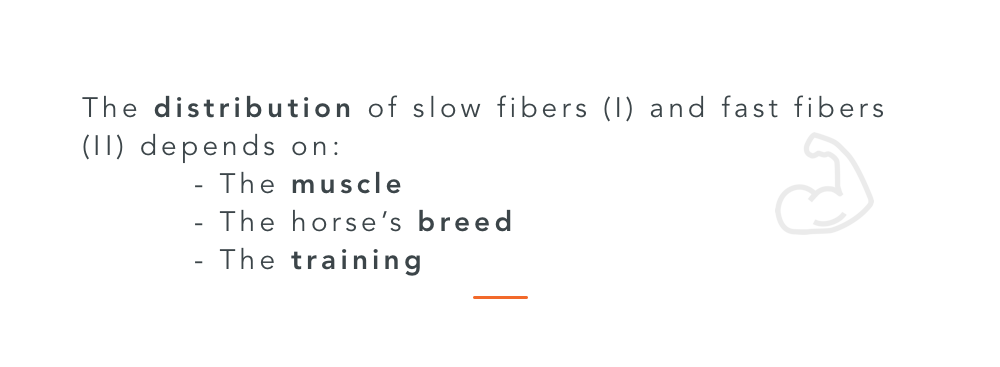
#4 – The overall training management for a well muscled horse
As explained above, the training management of a horse will vary depending on the discipline he is being trained for ! I will let Emmanuelle Van Erck tell you little about the overall training management.

Stamina
“For any type of training, no secret you must start by building a stamina base, working on exercises of low to moderate intensity (trotting hacks for example) for at least 45 minutes. This way we develop type I fibers that can “hold” the effort and recover the surplus in lactic acid produced by type II fibers
Muscle building
After 4 weeks, the muscles are ready to develop more resistance and strength. We therefore move towards the next step: muscle building, which is now influencing type II fibers. We introduce gym exercises 2 to 3 times a week: collected training, lateral training, cavalettis, small obstacles, water training. All these exercises can be done on uneven terrain or terrains of varying depth.
📚 Know more about it –> 5 exercises to develop your horse’s muscles
We are looking for relatively short but intensive exercises, with recovery phases during which the horse can recover and get his heart rate down. These exercises help developing the horse’s muscles: the benefit will be visible.
📚Know more about it –> What is collection?
If the exercise gets « long and slow » there is a risk of replacing fibers II with slow fibers: the horse loses its power. If it’s a jumping horse, it will lose its power and speed when jumping: so not too much walker or more than an hour flat sessions!
We can vary these sessions with outdoor sessions, where the horse can perform elongated canter, good for the condition, breathing and muscle stretching.
📚 Know more about it –> “Here’s the only way to improve your horse’s Fitness”
Recovery
Warning! After intensive sessions or competitions, it takes at least 48-72 hours for the horse’s muscle to fully recover (24 to 48 hours at home). It is therefore important not to do too many sessions over the week.
The horse is a great athlete: even when he walks in the field, he is 100 times better trained than any other human athlete. In addition, he responds very quickly to training and does not “train” as easily as we do. Even after a month of break, he loses almost nothing of his condition level. “
📚Know more about it –> “Recovery after an effort”
#5 – Agonist and antagonistic muscles
To train a horse well, it is important to know a little about biomechanics.
In fact, each muscle has another muscle that can do its opposite movement. These muscles are said to be antagonistic. Like the biceps and the triceps for example!
Thus, when we say that two muscles work agonistically, it is that both will facilitate the desired movement. When we say that they work in an antagonistic way, they will oppose each other! If I tell you about it, it is because these antagonistic muscles allow several types of contractions that one must combine in order to have a well muscled horse.
#6 – Different types of contractions
They are 3 types de contractions:
- Concentric: This type of contraction occurs when extremities of the muscle get closer to each other which therefore inflates. The antagonist muscle will stretch, leading to its extremities moving away. In the case of the arm, the biceps will “swell” and the triceps will stretch.
- Eccentric: this time, the muscle will contract as its extremities move away. How is this possible ? Let’s use the exemple of the arm again, this time with a weight in the hand. When you “lower the weight” and extend your forearm, the biceps will resist this movement as it stretches. It’s an eccentric contraction. The eccentric contraction is actually a braking force. The eccentric force develops a superior force than the concentric force.
- Isometric (or static): this time the contraction causes no movement. Let’s use the sitting trot example, it can happen (by mistake of course) to tighten your thighs to maintain your balance but they do not move. The internal muscle of the thigh (adductor) is therefore in isometric contraction. This type of effort creates an even greater force than the eccentric contraction.
To effectively muscle a specific area, it is necessary to use all 3 types of contractions! Which brings us to concrete examples …
On the same topic 📚 : 13 Stretching Exercises to do with your horse at home
#7 – Training exercises to muscles your horse
Please make a stop by these articles:
Neck: « how to make building neck muscles a piece of cake? »
Back and abdominals: ” 3 tips to efficiently build back muscles “
Chest: “Here is how to muscle your horse’s chest!”
Buttock: “Here is how to get your horse’s hindquarter muscled”
Now you know everything about these precious muscles that we care so much about! What more? you can follow all your training exercises with Equisense Motion, our connected sensor that analyzes your sessions! You will be able to know how much time you have walked, how many jumps you have made and make sure that your flat sessions do not exceed 1h.
Extra little help
Do not hesitate to give your horse supplements depending on its workload. Have a look at this supplement; Myostem Mass from Audevard laboratories. It is high in essential and limiting amino acids. These protein components are the base of the muscle cells. Muscle gain is often difficult because of the lack of these amino acids in the diet. Myostem mass helps promoting muscle gain!
It was therefore designed to participate in the muscular development of horses in training, aged horses and growing foal. It also helps to limit the muscle loss of horses in break!
Till the next article!
Camille Saute,
Resp. R&D at Equisense
Bibliography
HOWALD, H., & WASSERMANN, D. (1988). Typologie des fibres musculaires. Dans Bioénergétique de l’exercice musculaire et de l’entraînement physique (pp. 52-58). Paris: PUF.
SNOW, D. (1983). Skeletal muscle adaptation: a review. Dans D. SNOW, S. PERSSON, & R. ROSE, Equine Exercise Physiology (pp. 160-183). Cambridge: Granta Editions.
E. C. Authie, « Contribution à l’évaluation de la charge de travail des jeunes chevauc de concours complet d’équitation à l’entraînement et en compétition. », Oniris, 2011.
Illustrations
Hand by Ben Davis from the Noun Project
Muscle by Davis Gladis from the Noun Project
Intestines by TUXX from the Noun Project
Heart by Anthony Bossard from the Noun Project